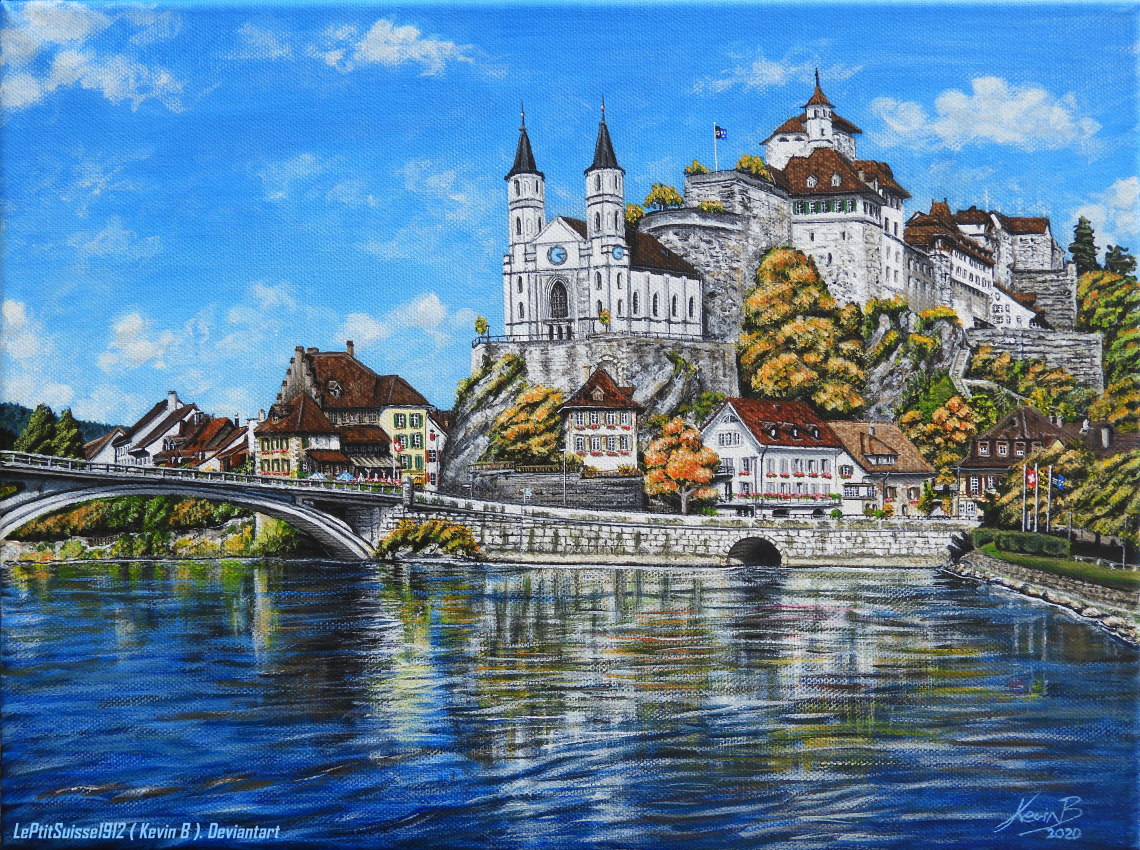
Aarburg sur la Toile
Description
Histoire d'Aarburg
La petite ville médiévale d’Aarburg se trouve au bord de l’Aare dans le district de Zofingue (ou Zofingen en allemand) dans le canton d’Argovie en Suisse.
Le Château est construit sur un éperon rocheux, sa construction est attribuée à Büron qui plus tard prit « Aarburg » comme patronyme. La place forte est mentionnée pour la première fois en 1123 de manière indirecte en citant un certain « Adelbero d'Aarburg », comte de Frohburg.
Le château a été construit à cet endroit car l’éperon rocheux où il se trouve domine la cluse de l’Aare qui était un lieu de passage important emprunter dès l’époque romaine permettant de relier Olten à la Suisse centrale et c’était donc un endroit parfait et stratégique pour installer un péage ;-)
Les Frohburg vendirent par la suite la seigneurie aux Ducs d’Autriche vers 1299. Les documents anciens ne citent jamais la ville d’Aarburg elle-même. Elle ne sera désignée en tant que ville qu’à partir de 1330.
Après un court siège, les Bernois s’emparent de la ville le 20 avril 1415 qui deviendra résidence des baillis l’année suivante. Par la Suite le château est transformé en forteresse entre 1659 à 1673 après la guerre des Paysans et la première guerre de Villmergen. Les ouvrages défensifs s’étalèrent sur la totalité de la colline. Des modifications et des extensions se succédèrent jusqu’au milieu du 18ème siècle. Les Bernois abandonnèrent la forteresse aux troupes françaises en mars 1798. En 1804 la ville d’Aarburg fût comprise dans le nouveau canton d’Argovie. Après quoi ce monument national servit d’arsenal et de pénitencier au 19ème siècle.
La vieille ville et le château furent ravagés par un incendie en 1840 puis reconstruits à l’exception d’une partie des fortifications. Et depuis 1893 le château sert de maison d’éducation pour jeunes délinquants.
L’église à double clochers de style néo-gothique a été construite sur l’emplacement de l’ancienne chapelle du château détruite par l’incendie. Elle fût reconstruite par Johann Jakob Heimlicher de 1842 à 1845.
Source des informations
https://hls-dhs-dss.ch/fr/articles/001810/2009-06-23/
Acrylic paint (30 x 40 cm). It's an order from my grandparents, because Aarburg is the city where they are met.
Town of Aarburg
The small medieval town of Aarburg is located on the banks of the Aare in the Zofingen district (Canton of Aargau, Switzerland).
The Castle is built on a rocky outcrop, its construction is attributed to Büron who later took "Aarburg" as a surname. The stronghold is mentioned for the first time in 1123 indirectly by citing a certain "Adelbero von Aarburg", count of Frohburg.
The castle was built at this location because the rocky spur where it's located dominates the Aare water gap which was an important crossing point borrow since Roman times to connect Olten to central Switzerland and it was therefore a perfect and strategic place to install a toll ;-)
The Frohburgs later sold the lordship to the Dukes of Austria around 1299. Ancient documents never cite the city of Aarburg itself. It will not be designated as a city until 1330.
After a short siege, the Bernese captured the city on April 20, 1415 which became the residence of the bailiffs the following year. Then the castle was transformed into a fortress between 1659 to 1673 after the Peasants' War and the First Villmergen War. The defensive structures spanned the entire hill. Modifications and extensions followed one another until the middle of the 18th century. The Bernese abandoned the fortress to French troops in March 1798. In 1804 the city of Aarburg was included in the new canton of Aargau. After which this national monument served as an arsenal and penitentiary in the 19th century.
The old town and the castle were devastated by a fire in 1840 and then rebuilt except for part of the fortifications. And since 1893 the castle has served as an educational center for young delinquents.
The neo-Gothic church was built on the site of the old chapel of the castle destroyed by fire. It was rebuilt by Johann Jakob Heimlicher from 1842 to 1845.
Source of information
https://hls-dhs-dss.ch/fr/articles/001810/2009-06-23/
Acrylgemälde (30 x 40 cm). Es ist ein Auftrag meiner Großeltern, denn Aarburg ist die Stadt, in der sie getroffen werden.
Stadt Aarburg
Die mittelalterliche Kleinstadt Aarburg liegt am Ufer der Aare im Bezirk Zofingen (Kanton Aargau, Schweiz). Das Schloss ist auf einem Felsvorsprung erbaut, sein Bau wird Büron zugeschrieben, der später "Von Aarburg" als Nachnamen übernahm. Die Festung wird 1123 erstmals indirekt unter Berufung auf einen bestimmten "Adelbero von Aarburg", Graf von Frohburg, erwähnt.
Das Schloss wurde an dieser Stelle erbaut, weil der Felsvorsprung, an dem es liegt, das Durchbruchstal der Aare beherrscht und eine wichtige Ausgrabungstelle aus der Römerzeit war, um Olten mit der Zentralschweiz zu verbinden Ein perfekter und strategischer Ort, um eine Maut zu erheben.
Die Frohburgs verkauften die Herrschaft später um 1299 an die Herzöge von Österreich. In alten Dokumenten wird die Stadt Aarburg selbst nie erwähnt. Es wird erst 1330 als Stadt ausgewiesen.
Nach einer kurzen Belagerung eroberten die Berner am 20. April 1415 die Stadt, die im folgenden Jahr Residenz der vögte wurde. Anschließend wurde die Burg zwischen 1659 und 1673 nach dem Bauernkrieg und dem Ersten Villmergenkrieg in eine Festung umgewandelt. Die Verteidigungsstrukturen erstreckten sich über den gesamten Hügel. Änderungen und Erweiterungen folgten bis Mitte des 18. Jahrhunderts. Die Berner überließen die Festung im März 1798 den französischen Truppen. 1804 wurde die Stadt Aarburg in den neuen Kanton Aargau eingegliedert. Danach diente dieses Nationaldenkmal im 19. Jahrhundert als Arsenal und Gefängnis.
Die Altstadt und die Burg wurden 1840 durch einen Brand zerstört und bis auf einen Teil der Befestigungsanlagen wieder aufgebaut. Und seit 1893 dient das Schloss als Bildungszentrum für junge Straftäter.
Die im neugotischen Stil errichtete Doppelglockenturmkirche wurde an der Stelle der alten Kapelle des durch einen Brand zerstörten Schlosses errichtet. Es wurde von Johann Jakob Heimlicher von 1842 bis 1845 umgebaut.
Informationsquelle
https://hls-dhs-dss.ch/de/articles/001810/2009-06-23/


Comments
You must be logged in to comment.